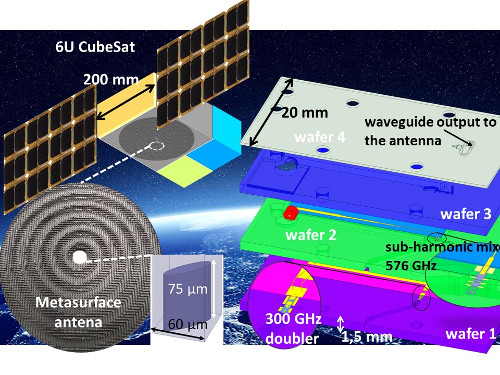TERACUBE: THz instrument concept for CubeSat
- 1CNRS Obs. Paris-Meudon, LESIA, Meudon, France
- 2CNRS Obs. Paris, LERMA, Paris, France
- 3Univ. Rennes, CNRS, IETR - UMR 6164, Rennes, France.
- 4C2N, UMR 9001, Université Paris-Saclay, Palaiseau, France.
Teracube is an instrument concept in the Tera-Hertz frequency range for planetary atmosphere remote sensing with a CubeSat. The TERACUBE-study goal is to initiate the development of a new ultra-compact and portable generation of heterodyne receivers centered at a frequency near 576 GHz. Such receiver is based on the technology currently carried on the L1-ESA JUpiter ICy Moons Explorer (JUICE) mission, (at 1200 GHz, the high frequency part of the Submillimeter Wave Instrument, is being developed and manufactured at LERMA/Observatoire de Paris). The compactness of this instrument will be such that it can be embarked on a CubeSat. This is motivated by the potentiality and viability for the study of planetary atmospheres in-situ, as demonstrated by the recent Mars Cube One cubesats (MarCO-A and MarCO-B) riding along with the NASA InSight mission, which succeeded in a flyby of Mars in 2018.
TERACUBE will operate at submillimetre (sub-mm) wavelengths, providing unique data on planetary atmosphere dynamics, composition and temperature. As a very good example, the TERACUBE science case applied to Venus atmosphere variability is complementary to the proposed ESA M5 mission ENVISION to study Venus atmosphere and geology. The high spectral resolution (e.g. 100 KHz) and sensitivity of such a heterodyne receiver will allow the spatial and temporal mapping of i) Doppler lineshifts winds, ii) abundance of minor species (e.g. CO(5-4) at 576 GHz, H2O110-101 at 557 GHz) down to a few ppb, and iii) atmospheric temperature, in the altitude range of 70-120 km on Venus.
In order for CubeSats scientific payloads to evolve towards the most compact architectures possible while integrating THz instruments, it is essential to consider the receiver and the antenna as a single unit, whereas until now the approach has been conservative and consisted of studying them separately.TERACUBE-study has two major objectives: 1) The system design of a high spectral resolution instrument at 576 GHz to achieve a reduction in mass and volume by a factor of 5 to 10 compared to existing solutions, and 2) Study and fabrication of the first bricks of the demonstrator (MMIC Schottky, Si micro-fabrication of the planar metasurface antenna). This high-risk interdisciplinary project, led by LERMA, brings together three different institutes, whose best areas of expertise will be used to ensure the success of this project: design and study of an integrated room temperature receiver using THz GaAs Schottky diodes (LERMA), microtechnologies (C2N: micro-machining on Si, GaAs Schottky diodes) and modulated metasurface antennas (IETR). TERACUBE-study proposes the first impetus for the integration of a THz instrument.

Figure 1: Left: Metasurface antenna integrated into the chassis of a CubeSat and typical dimensions for the 600 GHz unit cell. Right: Ultra-compact receiver (50×20×5 mm3) made with a stack-up of micro-machined Silicium wafers for integration of a 576 GHz Schottky heterodyne receiver.
Acknowledgements
This project is supported by LABEX ESEP : ANR-11-LABEX-0047 and programme d’investissement d’avenir : ANR-10-IDEX-0001-02 PSL
How to cite: Moreno, R., Treuttel, J., González-Ovejero, D., Gatilova, L., Segret, B., and Lellouch, E.: TERACUBE: THz instrument concept for CubeSat, Europlanet Science Congress 2020, online, 21 September–9 Oct 2020, EPSC2020-350, https://doi.org/10.5194/epsc2020-350, 2020

